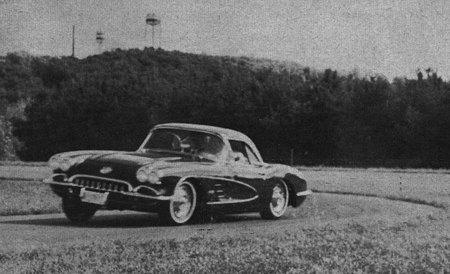Originally published in Sports Car Illustrated in December 1957.
For the guy who is really serious about his racing, a heavyduty brake and suspension package is offered in an all or nothing deal. To get this package, you must also order the “D” engine and the Positraction differential. But what a package! Stiffer front coils give a spring rate 13-1/2% higher. The anti-roll bar is 40% stiffer. The rear springs, with an extra leaf, have a 9-1/2% higher rate. The shock absorbers, with 88% larger working area, have different valving and finally, the steering ratio is changed from 21/1 to 16.3/1 by lengthening the third arm idler.
The famous Cerametallic brakes are fitted and it is interesting to note that although the drum diameter remains at eleven inches and the shoes are a full half inch wider, the total braking area is actually reduced 20%, because the forward shoes are lined over only half their length. To reduce the amount of braking done by the rear wheels, the brake cylinders there are only 0.875 inch diameter instead of one inch, whereas the front ones remain at 1.125. The drums have cooling fins cast on the rim, and as a further option, vented backing plates with air scoops are available. Those large holes up front that we mentioned before may then be opened up and a duct will carry air back, not just to the front brakes, but under the door sills all the way to the rear ones, too.
The Cerametalllic brakes are definitely not intended for all types of driving. Corvettes so equipped are delivered to the customer with a placard on the windshield which reads, “This car is not for street use”. Until warmed up, they are quite apt to pull strongly to one side or the other; not just the thing for Grandma on her jaunts to the grocery store!
Faced with the realities of the American scene, Chevrolet now follows tradition in marketing two apparently similar, yet actually quite different sports cars, one for the every day sort of user who might occasionally go racing, and another for the serious competitor in the Production category. However, in this case, the engine mods from the racing model are readily available without the HD brake and suspension kit, which may seem rather the wrong way around. But at least you can’t get the “D” engine with the Powerglide transmission! That would be too much!
One of the pleasanter aspects of this test was that, being in the nature of a sneak preview, the entire operation was conducted on GM’s Proving Grounds at Warren, Michigan. After the brake fade and acceleration tests were completed on a 1-1/2 mile level straight, we turned the Corvette loose on a sample road circuit that rather resembled Torrey Pines with its multiplicity of turns of varying radius, camber, and even surface texture. A visitor is said to have remarked naively that GM, with all its money, certainly could have afforded to build better roads than these. Be that as it may, we were able, in a very short time, to discover how the ’58 Corvette behaves in nearly every conceivable road situation. Briefly, it may be summed up as “very well indeed.”
There are no tricks at all to the steering, which is amazingly light at all times. We went through a series of ess-bends at speeds ranging from 40 to 70 mph. The only time the car felt at all uncertain was on a special piece of pavement featuring ridges running parallel to our direction of travel. The reaction here was pretty typical, the back end wanted to walk out somewhat when we crossed them on a diagonal. Elsewhere on the track, when we abruptly crested a sharp rise in the middle of a seventy miles an hour bend, the front of the car moved out only slightly, a tribute to a well-arranged front suspension and the high polar moment of inertia. On really tight hairpins, tighter ones than you have any right to be going that fast on, the steering is still light, though the steering lock seems to call for rubber arms. (The HD kit reduces the 3.7 turns lock to lock to under 3.)


Leave a Reply